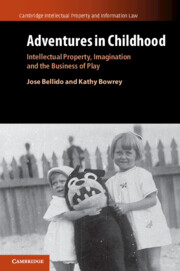Book contents
- Adventures in Childhood
- Cambridge Intellectual Property and Information Law
- Adventures in Childhood
- Copyright page
- Contents
- Figures
- Acknowledgements
- Abbreviations
- Introduction
- 1 Commercialisation and the Innocent Child
- 2 Books, Toy Books and the Artfulness of Consumption
- 3 Instructions for a Successful Boy
- 4 Animated Properties
- 5 Licensing Gone Wrong
- 6 The Rise of Merchandising Agencies
- 7 Troubles at the British Broadcasting Corporation
- Conclusion: Unsuitable for Children
- Index
- Cambridge Intellectual Property and Information Law
5 - Licensing Gone Wrong
Published online by Cambridge University Press: 30 June 2022
- Adventures in Childhood
- Cambridge Intellectual Property and Information Law
- Adventures in Childhood
- Copyright page
- Contents
- Figures
- Acknowledgements
- Abbreviations
- Introduction
- 1 Commercialisation and the Innocent Child
- 2 Books, Toy Books and the Artfulness of Consumption
- 3 Instructions for a Successful Boy
- 4 Animated Properties
- 5 Licensing Gone Wrong
- 6 The Rise of Merchandising Agencies
- 7 Troubles at the British Broadcasting Corporation
- Conclusion: Unsuitable for Children
- Index
- Cambridge Intellectual Property and Information Law
Summary
In 1929, J. M. Barrie made a bequest to the Great Ormond Street Hospital for Sick Children of his most popular creation, ‘Peter Pan’. Chapter 5 explores the dynamic of gift-giving for the benefit of vulnerable children and how this translated into licensing practices. A Peter Pan movie, to be directed by George Cukor and starring Audrey Hepburn, was never made because of the bitter relationship that developed between the licensor, the Great Ormond Street Hospital, and its licensee, the Disney Corporation, which resulted in litigation in the 1960s. By looking at the misfortune of a film that was never made, the chapter shows how licensing intangible properties involved not only a question of contract and property, but also a more complicated question of trust, sociality and the etiquette of managing commercial opportunities. The chapter engages in a deeper consideration of the impact of the Disney Corporation, not just in creating a highly effective managerial infrastructure to exploit the child as a consumer, but also in developing intellectual property strategies to gain a privileged position with consumers, who were now conceived of as being included within the Disney family.
Keywords
- Type
- Chapter
- Information
- Adventures in ChildhoodIntellectual Property, Imagination and the Business of Play, pp. 143 - 188Publisher: Cambridge University PressPrint publication year: 2022

